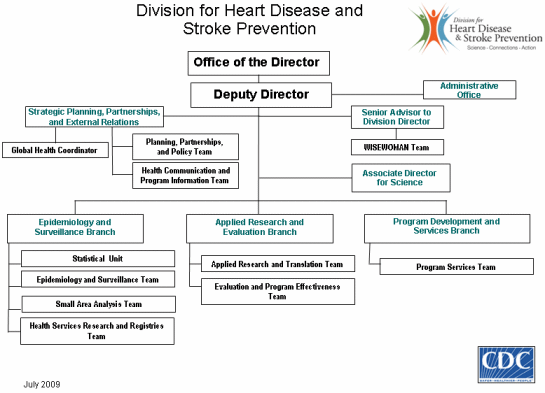 About Us
About Us
Our Vision
To create a heart-healthy and stroke-free world.
Our Values
- Accountability
- Collaboration
- Communication
- Integrity
- Leadership
- Respect
- Service
Our Work
CDC's Division for Heart Disease and Stroke Prevention works to improve cardiovascular health through public health strategies and policies that promote
- Healthy lifestyles and behaviors.
- Health environments and communities.
- Access to early and affordable detection and treatment.
With Fiscal Year 2011 appropriations of $55.3 million for Heart Disease and Stroke Prevention and $20.7 million for the WISEWOMAN program, CDC employs science, connections, and action to prevent, detect, and improve standards of care for heart disease and stroke and to reduce associated health disparities.
Funded Programs
- National Heart Disease and Stroke Prevention Program
CDC funds state health departments to provide heart disease and stroke prevention programs at the state and local levels. Funded states develop plans and work with partners to promote policy and system changes that help to control high blood pressure and cholesterol; increase awareness of the signs and symptoms of heart attack and stroke; improve emergency response and quality of health care; and eliminate health disparities among population groups. - Paul Coverdell National Acute Stroke Registry
CDC funds state health departments to set up surveillance systems that measure, track, and provide data to improve the delivery and quality of stroke care among acute stroke patients. The goal of the Coverdell Registry is to ensure that all Americans receive the highest quality of acute stroke care available to reduce untimely deaths, prevent disability, and avoid recurrent strokes. - WISEWOMAN
CDC funds states and tribal organizaztions to offer WISEWOMAN programs in local clinics and public health departments. WISEWOMAN is a prevention program that provides risk factor screenings, lifestyle interventions, and referrals to uninsured and underinsured, 40- to 64-year-old women, to help reduce their risk for heart disease, stroke, and other chronic diseases. Through tailored programs, WISEWOMAN provides women with education, skills, and resources to quit smoking and improve their diet, physical activity, and other lifestyle behaviors. - Cardiac Arrest Registry to Enhance Survival (CARES)
Every minute counts during an out-of-hospital cardiac arrest (OHCA). When an OHCA occurs, emergency medical services (EMS) providers usually are the first to respond. To help EMS providers improve their performance in these situations and save more lives, CDC created the Cardiac Arrest Registry to Enhance Survival (CARES) in collaboration with Emory University and the American Heart Association.
Core Functions
Programs
To prevent heart disease and stroke, and eliminate health disparities, CDC provides to state health departments, tribes, and other partners
- Funding
- Technical support
- Resources
Research
- CDC engages in applied research to support evidence-based practice.
- Through our research, science translation, and resource development, CDC helps state and national health agencies implement public health strategies to address the burden of heart disease and stroke.
Surveillance
- CDC tracks trends in cardiovascular risk factors and diseases, and documents differences in their distribution by age, gender, race/ethnicity, socioeconomic status, and geographic location.
- CDC shares these findings with our many partners and collaborates in applying public health strategies to improve cardiovascular health.
Evaluation
- CDC evaluates programs, policies, and interventions to ensure they are working as planned and producing the intended results.
Partnerships
- CDC partnerships with government agencies, states, and public and private organizations allow us to maximize collective resources.
Resource Management
- CDC promotes integrity and accountability in all administrative transactions.
- CDC works to ensure recruitment, retention, and training policies sustain a highly skilled and diverse workforce.
Organizational Chart

Get email updates
To receive email updates about this page, enter your email address:
Contact Us:
- CDC/NCCDPHP/DHDSP
4770 Buford Hwy, NE
Mail Stop F-72
Atlanta, GA 30341-3717 - Call: 800-CDC-INFO
TTY: 800-232-6348
Fax: 770-488-8151 - cdcinfo@cdc.gov



